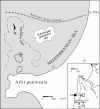Detection and molecular characterization of 9,000-year-old Mycobacterium tuberculosis from a Neolithic settlement in the Eastern Mediterranean
- PMID: 18923677
- PMCID: PMC2565837
- DOI: 10.1371/journal.pone.0003426
Detection and molecular characterization of 9,000-year-old Mycobacterium tuberculosis from a Neolithic settlement in the Eastern Mediterranean
Abstract
Background: Mycobacterium tuberculosis is the principal etiologic agent of human tuberculosis. It has no environmental reservoir and is believed to have co-evolved with its host over millennia. This is supported by skeletal evidence of the disease in early humans, and inferred from M. tuberculosis genomic analysis. Direct examination of ancient human remains for M. tuberculosis biomarkers should aid our understanding of the nature of prehistoric tuberculosis and the host/pathogen relationship.
Methodology/principal findings: We used conventional PCR to examine bone samples with typical tuberculosis lesions from a woman and infant, who were buried together in the now submerged site of Atlit-Yam in the Eastern Mediterranean, dating from 9,250-8,160 years ago. Rigorous precautions were taken to prevent contamination, and independent centers were used to confirm authenticity of findings. DNA from five M tuberculosis genetic loci was detected and had characteristics consistent with extant genetic lineages. High performance liquid chromatography was used as an independent method of verification and it directly detected mycolic acid lipid biomarkers, specific for the M. tuberculosis complex.
Conclusions/significance: Human tuberculosis was confirmed by morphological and molecular methods in a population living in one of the first villages with evidence of agriculture and animal domestication. The widespread use of animals was not a source of infection but may have supported a denser human population that facilitated transmission of the tubercle bacillus. The similarity of the M. tuberculosis genetic signature with those of today gives support to the theory of a long-term co-existence of host and pathogen.
Conflict of interest statement
Figures



References
-
- World Health Organisation. Tuberculosis. Fact sheet 104. 2008. Revised April 2008. Available: http://www.who.int/tb/publications/2008/factsheet_april08.pdf Accessed 2008 Jun 2.
-
- O'Reilly LM, Daborn CJ. The epidemiology of Mycobacterium bovis infections in animals and man: a review. Tuber Lung Dis 76 Suppl. 1995;1:1–46. - PubMed
-
- Ortner DJ, Putschar WG. Identification of pathological conditions on human skeletal remains. Washington DC: Smithsonian Institution Press; 1981.
Publication types
MeSH terms
Substances
LinkOut - more resources
Full Text Sources
Medical

